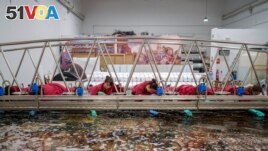Spain's Royal Tapestry Factory has been providing clothes, called carpets for the floor and tapestries for the wall, for palaces and public buildings for more than 300 years.
Found on a quiet street in Spain's capital Madrid, its artisans combine long-held knowledge of the work with new methods to create cloth-based products.
The factory was opened in 1721 by Spain's King Felipe V. He brought in Catholic artisans from Flanders, an area found in today's Belgium, to get it started. At the time, the area had been under Spanish control.

Staff workers clean a tapestry at the Royal Tapestry Factory in Madrid, Spain, Friday, Nov. 30, 2023. (AP Photo/Manu Fernandez)
Cloth like wool can be found in all colors in the factory. And tools like bobbins and spinning wheels are everywhere in the factory. Some of the original wooden machines are still in use.
Alejandro Klecker de Elizalde is the factory's general director. "Here the only products we work with are silk, wool, jute, cotton, linen," he said. "And these small leftovers that we create, the water from the dyes, or the small pieces of wool, everything is recycled, everything has a double, a second use."
The factory also brings old pieces that have been damaged through time back to good condition. And it keeps some of the most important cloth and material records in Europe.
Now, 70 percent of its buyers are individuals from Latin America, Europe, and the Middle East.
The factory recently received one of its biggest orders, 32 tapestries for the Palace of Dresden in Germany. The order is worth more than 1 million dollars and it will provide work for up to five years, Klecker de Elizalde said.
In 2018, the factory finished a tapestry for a Lebanese buyer based on the work Sabra and Shatila Massacre by Iraqi artist Dia al-Azzawi. The cloth shows the 1982-83 violence by Christian Phalangist militia in Palestinian refugee camps that were guarded by Israeli troops.
Creating a tapestry is a difficult process that takes several weeks or months of work for each square meter.
A tapestry begins with "cartoons," or drawings on paper that are later copied onto a system of material called warps which are then woven over.
One of the factory's well-known cartoonists was master painter Francisco Goya, who began working there in 1780. Some of the tapestries he designed are now found in the nearby Prado Museum and Madrid's Royal Collections Gallery.
I'm Jill Robbins.
Irene Yagüe reported this story for The Associated Press. Gregory Stachel adapted it for VOA Learning English.
______________________________________________
Words in This Story
palace – n. the official home of a king, queen, or president
dye – n. a substance used for changing the color of something (such as hair or cloth) usually permanently
recycle – v. to make something new from (something that has been used before)
warp – n. the threads that run up and down on a loom or in a woven fabric
weave – v. to make something (such as cloth) by crossing threads or other long pieces of material over and under each other
